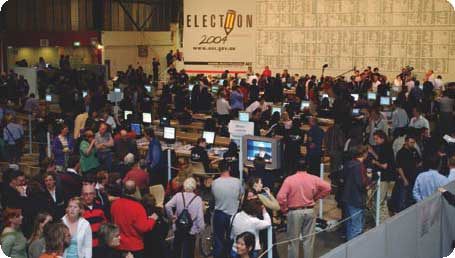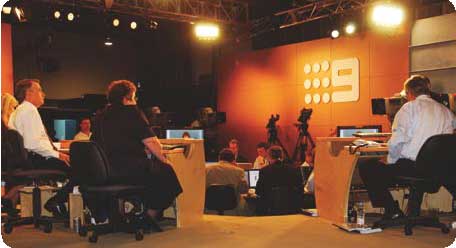Election Night
In this Section:
The counting of votes, known as the scrutiny, begins in each polling place after they close their doors at 6pm on election day.
Counting at polling places
Polling officials are required to complete four main tasks at the close of polls in the following order:
- Count the first preferences on the House of Representatives ballot papers
- Conduct a two-candidate-preferred (TCP) count of the House of Representatives ballot papers
- Count the first preferences on the Senate ballot papers; and
- Count and sort the declaration vote envelopes received during the day (these remain unopened).
Only ordinary votes can be counted on election night. Absent and provisional votes cast at the polling place are put aside as checks must be made at the divisional office to ensure that these ballot papers are eligible to be included in the count.
House of Representatives count on election night
Immediately after the doors close the polling officials open and empty the House of Representatives ballot boxes. The green ballot papers are unfolded and all the number ‘1’ votes (first preferences) are counted for each candidate and put into separate piles. The informal ballot papers are also counted and set aside separately. The first preference results for each candidate are tabulated and phoned through to the DRO, along with the number of informal ballot papers. The DRO enters the figures received from each polling place in their division into the AEC’s national computerised Election Night System. The figures entered into the computer system are transmitted to the National Tally Room in Canberra where they are available on computer terminals and displayed on the National Tally Board.

700 members of the media attended the National Tally Room at Exhibition Park in Canberra.
This information is also made available in a virtual tally room on the AEC’s website and provided to television networks.
Two-Candidate-Preferred Count for House of Representatives
Polling officials then conduct a two-candidate-preferred (TCP) count, which is a distribution of preferences to two selected candidates. The TCP count is conducted to give an early indication of who is most likely to win each seat as this is not always clear from first preferences. The AEC selects the two candidates for the TCP count based on a number of factors including historical voting patterns in previous elections. The names of the two candidates are kept confidential until the close of the poll. The ballot papers for all other candidates are examined to see which of the two selected candidates the elector has put ahead in their preferences. This result is then tabulated and telephoned to the DRO, who in turn enters it into the computerised Election Night System, where it is made available at the National Tally Room and to a wider audience on the Virtual Tally Room.
Senate count on election night
Following the House of Representatives count, the polling officials open and empty the Senate ballot boxes.
The white ballot papers are unfolded and all the number ‘1’ votes for groups and for ungrouped candidates below the line are counted. First preference votes for groups are determined by counting separately and then combining the number ‘1’ votes for groups above the line, and the number ‘1’ votes for individual members of groups below the line. The first preference votes for groups and ungrouped candidates are tabulated and phoned through to the DRO, who enters these figures into the computerised Election Night System. Because Senate results cannot be calculated until the Statewide total of votes used to determine the ‘quota’ is known, it is usually not possible to get more than a general impression of the Senate results on election night. The polling officials then place all the House of Representatives and Senate ballot papers into sealed parcels and deliver them, and the declaration votes to the DRO.
Scrutineers during the scrutiny
Candidates may appoint scrutineers as their personal representatives to observe the counting of the votes at polling places. Scrutineers have the right to observe all stages of the scrutiny and can challenge the formality of ballot papers but they cannot touch any ballot paper.
National Tally Room
The National Tally Room (NTR) is organised by the AEC to provide a central point for the display of election results on election night. The NTR is one of Australia’s largest media gatherings with representation from the radio, print and television media. Election results are transmitted from every divisional office around Australia via the computerised Election Night System. The results are displayed on rows of computer terminals which are available to the media and members of registered political parties. The results are also simultaneously fed to the television networks who present their election coverage from temporary sets constructed at the back of the NTR. A manual backup system using facsimile and telephones is installed in case of computer problems. Election figures started coming into the 2004 NTR at approximately 5.20pm, mainly from the smaller polling places in Tasmania. The figures kept coming in until midnight when the final Western Australian figures for the night were available.
The election figures for the House of Representatives are also displayed on a manual tally board which dominates the front of the NTR. The tally board provides a backdrop for the television coverage of the election and is read by the many members of the public who visit the NTR. The tally board also provides a backup system in case of computer failure. The AEC also provided computer terminals directly linked to the election results system to the Prime Minister and the Leader of the Opposition.
National Tally Room Preparations
The NTR for the 2004 federal election was located at Exhibition Park in Canberra. It took about two weeks to build, three days to dismantle and many months of detailed planning to organise.
Transforming the empty hall into the central point on election night was a massive logistical exercise. The AEC had access to the building from 27 September when the work began on:
- laying the temporary floor
- building the 35 metre x 7 metre tally board
- allocating space to the media, parties and television networks
- organising the electricity supply, air conditioning, telecommunication lines and computer cabling.
Elaborate security arrangements were in place during the building of the tally room and on election night. To ensure the smooth running of the NTR the AEC also conducted a rehearsal on the Thursday before election day to test the computer system and to provide training for the casual staff employed on the National Tally Board and in divisional offices throughout Australia.

Temporary studios broadcast election information to millions across Australia
The NTR cost approximately $650 000 to organise. This included the hire of venue, communication and computing facilities, equipment hire, casual staff wages and security. The television networks met the costs of constructing their own sets.
National Tally Room Logistics
The NTR included:
- 700 members of the media
- four major and two minor purpose-built television studios
- 100 political party workers and Members of Parliament
- 160 international and other official guests
- 150 AEC and other NTR workers
- 2 400 members of the public (a maximum of about 300 at any one time).
On the technical side there were:
- 84 terminals, four printers and 7 separate data feeds
- six kilometres of telephone cables
- 8.5 kilometres of computer cabling
- two mobile telephone repeater stations
- in excess of 300 mobile and 150 static telephones
- up to 650 amps of electrical load (enough to power a small town).
